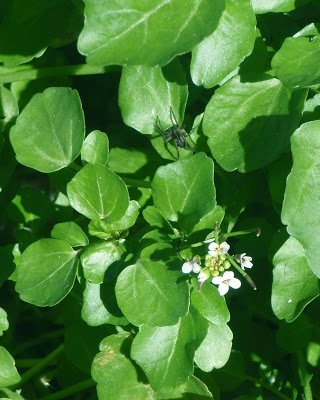
by Tammera J Karr, PhD
Watercress is an aquatic leafy green plant that is a close cousin to mustard greens, cabbage, and arugula. Watercress tastes much like the wild Miners lettuce of the Pacific Northwest. Watercress has been cultivated in Europe, Central Asia, and the Americas for millennia, for use as both food and medicine. Hippocrates, the father of medicine, is thought to have selected the location for his first hospital based on its proximity to a stream, so he could use only the freshest watercress to treat his patients. Watercress is believed by many to be an aphrodisiac. In Crete, islanders swear by its powers and ancient recipes are handed down from one generation to the next.
Irish monks were said to survive for long periods eating only bread and watercress and referred to watercress as ‘pure food for sages.’ Watercress is a rich source of vitamin C historically it was chiefly valued as an antiscorbutic (prevent scurvy). [1]
Hampshire Watercress (Nasturtium officianale) is noted for its distinctive peppery, mustard-like flavor, best known for its traditional use as a classic ingredient for soup. Watercress will, contrary to popular belief, grow anywhere that is moist, escaping cultivation to become an invasive species in many areas of the Pacific Northwest. The period of April and May is believed to be the best time to harvest or wildcraft. [2]
Watercress was used as a salad vegetable and added to stews. The juice pressed from watercress was used for gravies to accompany roast meats in medieval France. Watercress was often eaten in-between courses to cleanse the palate. Watercress was promoted during the First World War as an important health-giving homegrown food. [3]
One of Britain’s best-known dishes, watercress soup, became very popular in the 17th century when it was claimed to cleanse the blood. Victorians thought the plant was a cure for a toothache, hiccups and even freckles! Watercress is mentioned so often as an ingredient in detox vegetable juice recipes and as a cure for a variety of ills, that it could virtually be viewed as a staple part of the regime for those wishing to juice their way to health. [4], [5]
Watercress is versatility, it can be used as a salad green with Romaine lettuce or fresh spinach, steamed and eaten as a vegetable, and in soups for a subtle, peppery flavor, in sandwiches and wraps.
Health Benefits of Watercress
Modern science has identified more than 15 essential vitamins and minerals contained in this one herb – more iron than spinach, more calcium than milk, and more vitamin C than oranges. Watercress is low in calories but contains phytonutrients like isothiocyanates and antioxidants with a plethora of disease-preventive properties. Gluconasturtiin, a glucosinolate compound providing the peppery flavor, is one of them, held in the leaves and stems and providing phenethyl isothiocyanates, shown to inhibit carcinogens.
Vitamin K is the most prominent nutrient in watercress, with 312 percent of the daily recommended value. It forms and strengthens the bones and limits neuronal damage in the brain, which is helpful in treating Alzheimer’s disease. There’s also vitamin C, with 72 percent of the daily value, closely followed by vitamin A with 64 percent. Vitamin C provides top-notch infection-fighting power to stave off colds and flu, help maintain healthy connective tissue, and prevent iron deficiency. Vitamin A, also known as retinol, is essential for a properly functioning immune system and produces pigments in the retina of the eye, an absence of which can cause night blindness.
Manganese is a cofactor for the antioxidant enzyme superoxide dismutase and calcium in high doses when you eat watercress. Antioxidant flavonoids, ß carotene, zeaxanthin, and lutein protect from lung and mouth cancers. B-complex vitamins include riboflavin, niacin, vitamin B6 (pyridoxine), thiamin, and pantothenic acid, essential for keeping cellular metabolic functions at peak performance.
Eating watercress on a regular basis can significantly reduce DNA damage to blood cells and further to resist DNA damage caused by free radicals, according to a two-year research project at the University of Ulster.
Scientists examined a watercress-derived compound called phenylethyl isothiocyanate (PEITC) and found significant anticancer properties. Single-blind, randomized, crossover trials involved 60 healthy men and women eating about 1½ cups of fresh watercress daily for eight weeks. Positive results included a reduction in blood triglyceride levels by an average of 10 percent, and a significant (33 percent to 100 percent) increase in lutein and beta-carotene content, associated, with higher intake levels, in a lowered incidence of eye diseases such as cataracts and macular degeneration.
Scientific research found that the PEITC in watercress may suppress breast cancer cell development. Studies at the University of Southampton study found PEITC may starve tumor growth of blood and oxygen by “turning off” a signal in the body. Researchers explained that “as tumors develop, they rapidly outgrow their existing blood supply, so they send out signals that make surrounding normal tissues grow new blood vessels into the tumor, which feed them oxygen and nutrients.”
Irish Watercress Soup
Servings: 4-6
6 tablespoons Kerry butter
2 medium Yukon gold or red potatoes
1 cup chopped leeks (white only)
3 cups vegetable or chicken broth
1 cup ½ and ½ or cream
2 bunches watercress
Slice the leeks & saute in butter in a heavy pot on medium heat. Peel & chop potatoes & add to leeks and give a good stir. Pour in the broth, bring to a boil, cover & cook until the vegetables are soft (about 20 minutes). Remove the coarser stems from the watercress and chop the rest, leaving a few sprigs for garnish. Add to the pot & cook uncovered for 4 to 5 minutes. Do not overcook or watercress will lose color. Puree in a blender, return to pot, add cream & reheat slowly. Adjust seasonings. Serve decorated with reserved sprigs of watercress.
Add salt & pepper to taste
Sources
[6] http://hungerandthirstforlife.blogspot.com/2011/02/wild-about-watercress.html
Check Out Our Online Course
Let’s Begin the Journey of a Lifetime!